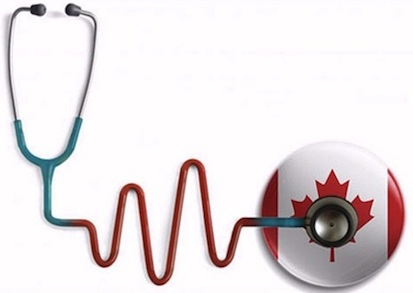 September 21, 2012 – Canadians are generally proud of our healthcare system, even if we know it’s not always perfect. We don’t have the same concerns about insurance coverage that our neighbours in the US have and we don’t generally go bankrupt seeking medical care, which is the single leading cause of personal bankruptcy in the US.
September 21, 2012 – Canadians are generally proud of our healthcare system, even if we know it’s not always perfect. We don’t have the same concerns about insurance coverage that our neighbours in the US have and we don’t generally go bankrupt seeking medical care, which is the single leading cause of personal bankruptcy in the US.
Even still, universal healthcare in Canada is not free, even if we don’t pay out of pocket for most procedures. Most provinces are getting close to dedicating half of their budget spending on healthcare and Canadians contribute a sizable share of their tax dollars to healthcare. But most Canadians don’t know the true cost of healthcare.
The true cost of healthcare
According to a new report by the Fraser Institute this misunderstanding about the cost of healthcare at the individual level “occurs partly because Canadians do not incur direct expenses for their use of health care, and partly because Canadians cannot readily determine the value of their contribution to public health care insurance.” The report calculated that 24.3% of tax revenues was spent on healthcare and used that percentage to determine what portion of the taxes we each pay was used to fund health care – the “public health insurance premium”. So then, for 2012, “the estimated average payment for public health care… ranges from $3,418 to $11,401” depending on your family income and status. Thus those in lower and higher income brackets may pay less or more than the average range. This range is still well below the American average, which is estimated at about $20,000 for an average family of four not including the very high deductibles in some policies.
And as high as that average range seems, growth in healthcare costs are rising faster than other basic necessities of life. “For the average Canadian family, between 2002 and 2012, the cost of public health care insurance increased more than twice as fast as the cost of shelter, roughly four times as fast as food, more than five times as fast as clothing, and 1.6 times faster than average income,” according to the report. “The 10 per cent of Canadian families with the lowest incomes will pay an average of about $487 for public health care insurance in 2012. The 10 per cent of Canadian families who earn an average income of $55,271 will pay an average of $5,285 for public health care insurance, and the families among the top 10 per cent of income earners in Canada will pay $32,628.”
As eye-opening as these numbers are, it could be worse. In the US, illness or medical bills contributed to over 60% of all bankruptcies in 2007. Still, Canadians have every right to be concerned about the direction of our health care spending.
The need for policies that improve quality and reduce cost
As good or bad as we may think our system is, it’s not free and Canadian taxpayers are the ones who foot the bill, which is why CARP’s advocacy on healthcare calls for policies that will not only improve quality of care and access, but will drive down system costs too. Home care is the perfect example. Not only do Canadians want to age at home, but creating a system that promotes and fosters homecare can lead to massive savings of between 40-70% compared to institutional care.
The same is true for CARP advocacy on caregivers. In 2007, 2.7 million Canadians aged 45 and older reported providing care for seniors, the value of the unpaid labour contributed by informal caregivers is estimated to be $25 billion per year. In one study, researchers compared the cost of a proposed care-giving allowance of $200/month and services evaluated at $25/hour with the cost of a bed in a long-term care facility at $130/day. Results showed that the savings from their proposed policy would be 6 times the projected long-term care facility cost.
Despite the vast potential of these and other cost saving policies, the federal government walked away from the health negotiating table last winter, opting instead to just give provinces money with no strings attached. This summer, provincial premiers released a very modest plan for health innovation, the features of which included clinical practice guidelines for two major chronic diseases – cardiovascular disease and diabetes – and a plan to reduce the costs of 3-5 generic drugs. Hardly a big step forward.
As a result, Canada’s health care system is still a patchwork eight years and billions of tax dollars after the 2004 Health Accords. Canadians are waiting for real action and real innovation.
Older Canadians, in particular, are now more demanding and willing to accept innovative solutions. Homecare, care giving, pharmacare, and patient-centered continuing care are just such policies. And together with our members, CARP Advocacy will continue demanding more health innovation from our governments, until we get more bang for our healthcare bucks.

